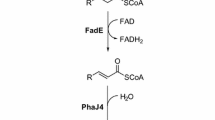Abstract
Polyhydroxyalkanoates are polyesters synthesized by numerous microorganisms. These polyesters are biodegradable and have similar properties to those of conventional plastics. Cupriavidus taiwanensis strain 184 is phylogenetically related to the well-known polyhydroxybutyrate (PHB) producer Ralstonia eutropha (Cupriavidus necator) and is also shown to be able to accumulate significant amounts of PHB. In this study, we cloned the PHB synthesis genes (phaCAB) from C. taiwanensis 184 into Escherichia coli for biosynthesis of PHB. The recombinant E. coli strains were able to synthesize significant amounts of PHB. The PHB amounted to about 66∼70% of total cell material of these recombinant strains.

Similar content being viewed by others
References
Weiner, R. M. (1997). Trends in Biotechnology, 15, 390–394.
Kim, Y. B., & Lenz, R. W. (2001). Advances in Biochemical Engineering/Biotechnology, 71, 51–79.
Rehm, B. H. A. (2003). The Biochemical Journal, 376, 15–33.
Chien, C.-C., Chen, C.-C., Choi, M.-H., Kung, S.-S., & Wei, Y.-H. (2007). Journal of Biotechnology, 132, 259–263.
Luengo, J. M., Garcia, B., Sandoval, A., Naharro, G., & Olivera, E. R. (2003). Current Opinion in Microbiology, 6, 251–260.
Reddy, C. S. K., Rashmi, R. G., & Kalia, V. C. (2003). Bioresource Technology, 87, 137–146.
Steinbüchel, A., & Füchtenbusch, B. (1998). Trends in Biotechnology, 16, 419–427.
Steinbüchel, A., & Valentin, H. E. (1995). FEMS Microbiology Letters, 128, 219–228.
Sudesh, K., Abe, H., & Doi, Y. (2000). Progress in Polymer Science, 25, 1503–1555.
Kung, S.-S., Chuang, Y.-C., Chen, C.-H., & Chien, C.-C. (2008). Letters in Applied Microbiology, 44, 364–371.
Khanna, S., & Srivastava, A. K. (2005). Process Biochemistry, 40, 607–619.
Park, S. J., Choi, J.-I., & Lee, S. P. (2005). Journal of Microbiology and Biotechnology, 15, 206–215.
Li, R., Zhang, H., & Qi, Q. (2007). Bioresource Technology, 98, 2313–2320.
Chien, C.-C., & Ho, L.-Y. (2008). Letters in Applied Microbiology, 47, 587–593.
Horng, Y.-T., Chang, K.-C., Chien, C.-C., Wei, Y.-H., Sun, Y.-M., & Soo, P.-C. (2010). Letters in Applied Microbiology, 50, 158–167.
Schlegel, H. G., Gottschalk, G., & Von Bartha, R. (1961). Nature, 191, 463–465.
Vandamme, P., & Coenye, T. (2004). International Journal of Systematic and Evolutionary Microbiology, 54, 2285–2289.
Kim, B. S., Lee, S. Y., & Chang, H. N. (1992). Biotechnological Letters, 14, 811–816.
Hahn, S. K., Chang, Y. K., & Lee, S. Y. (1995). Applied and Environmental Microbiology, 61, 34–39.
Lee, Y.-H., Park, J.-S., & Huh, T.-L. (1997). Biotechnological Letters, 19, 771–774.
Shin, H.-D., Lee, J.-N., & Lee, Y.-H. (2002). Biotechnological Letters, 24, 1729–1735.
Chen, W.-M., Laevens, S., Lee, T.-M., Coenye, T., De Vos, P., Mergeay, M., et al. (2001). International Journal of Systematic and Evolutionary Microbiology, 51, 1729–1735.
Amadou, C., Pascal, G., Mangenot, S., Glew, M., Bontemps, C., Capela, D., et al. (2008). Genome Research, 18, 1472–1483.
Spiekermann, P., Rehm, B. H. A., Kalscheuer, R., Baumeister, D., & Steinbüchel, A. (1999). Archives of Microbiology, 171, 73–80.
Kansiz, K., Billman-Jacobe, H., & McNaughton, D. (2000). Applied and Environmental Microbiology, 66, 3415–3420.
Braunegg, G., Sonnleitner, B., & Lafferty, R. M. (1978). European Journal of Applied Microbiology and Biotechnology, 6, 29–37.
Jan, S., Roblot, C., Goethals, G., Courtois, J., Courtois, B., Nava Saucedo, J. E., et al. (1995). Analytical Biochemistry, 225, 258–263.
Tsuge, T., Yano, K., Imazu, S.-I., Numata, K., Kikkawa, Y., Abe, H., et al. (2005). Macromolecular Bioscience, 5, 112–117.
Lee, S. Y., & Choi, J. I. (2001). Advances in Biochemical Engineering/Biotechnology, 71, 183–207.
Chen, G.-Q. (2009). Chemical Society Reviews, 38, 2434–2446.
Snell, K. D., & Peoples, O. P. (2009). Biofuels Bioprod. Biorefin, 3, 456–467.
Acknowledgment
We thank Dr. Thomas J Lie, University of Washington, Seattle, WA, USA, for his critical review and editing assistance of this manuscript. The present study was supported partly by grants (contract number NSC98-2622-E-155-003-CC2 and NSC97-2221-E-155-006-MY3) from National Science Council.
Author information
Authors and Affiliations
Corresponding author
Rights and permissions
About this article
Cite this article
Chien, CC., Hong, CC., Soo, PC. et al. Functional Expression of phaCAB Genes from Cupriavidus taiwanensis Strain 184 in Escherichia coli for Polyhydroxybutyrate Production. Appl Biochem Biotechnol 162, 2355–2364 (2010). https://doi.org/10.1007/s12010-010-9008-y
Received:
Accepted:
Published:
Issue Date:
DOI: https://doi.org/10.1007/s12010-010-9008-y




